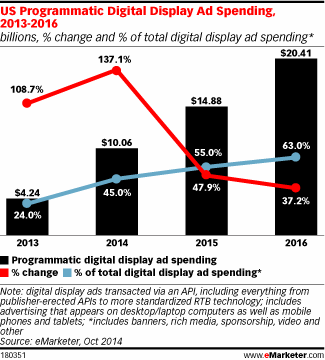Without a shadow of doubt, the most significant change to the online-advertising industry over the past few years has been the introduction and rapid rise of programmatic.
The sharp increase in popularity was recently highlighted by AppNexus president Michael Rubenstein, who stated that just five years ago, almost none of the ads displayed on the Internet were purchased or sold programmatically, whereas in 2015, more than 80% of display ads are bought or sold this way.
This growth is supported by recent financial figures from eMarketer.

What Does Programmatic Mean?
There is a lot of confusion inside and outside of the online display-advertising industry as to what programmatic media buying actually means.
In simple terms, programmatic refers to the buying and selling of digital advertising using technology, algorithms, and data.
The types of technology platforms used include demand-side platforms (DSP), supply-side platforms (SSP), data-management platforms (DMP), and ad exchanges.
Within these technology platforms lie algorithms capable of making accurate decisions about which ads to buy based on gathered and analyzed data.
Programmatic media buying allows advertisers and agencies to optimize campaigns and make the whole process much more efficient.
In the early days of programmatic, it was mainly confined to display ads but has recently moved into mobile, video, and more recently, television.
Programmatic TV
Programmatic TV works in the same way as programmatic media buying on digital advertising – it uses technology rather than humans to purchase media – but there are a few slight differences:
In the digital-advertising world, media bought and sold programmatically is often, but not always, done through real-time bidding (RTB) auctions. Currently, programmatic TV doesn’t utilize RTB auctions.
The main reason for this difference is because the online-advertising industry has an abundant supply of available inventory – just think of all the millions of websites with ad space that exist – whereas television has fewer opportunities to display ads to audiences.
Also, the decades-old infrastructure TV networks use to broadcast shows isn’t capable of handling modern advertising technology.
So then what is programmatic TV?
Programmatic TV revolves around two main areas: data and automation.
Data
Traditionally, TV ad space is purchased based on certain criteria, such as age, gender, demographics, and geographics. This data is often derived from the TV shows themselves. For example, a network may state that a show like Game of Thrones is mainly watched by men between the ages of 18 and 35 who live in the New York area.
With programmatic TV, data is collected from a range of different sources, such as from the TV networks, set-top boxes, and media monitoring and research companies.
Automation
Programmatic TV also involves buying advertising space in an automated fashion based on analyzed data. Instead of having humans do the data collecting and analyzing, advertisers and ad agencies can use technology to automate the process for better targeting.
Video, Linear TV, and Non-Linear TV advertising
There are currently many forms of TV advertising:
Video Advertising
When you think about video advertising, try not to confuse it with television advertising – they are not the same thing, although it’s getting more difficult to differentiate between the two.
Video advertising refers to ads displayed in the form of a video, instead of their traditional static form, such as banner ads.
These types of ads are commonly found on video sites like YouTube, but are also making their way to static websites and increasingly towards mobile.
Linear TV Advertising
Linear TV is where the viewer has to watch a certain program at a certain time set by the broadcaster.
Examples of linear TV include traditional television, pay-per-view programs, and pay/cable television. Because of the way linear TV works with regards to scheduling and ad purchasing, programmatic linear TV will never be real-time.
Non-Linear TV Advertising
Non-linear TV is the exact opposite of linear TV in that the viewer can choose when they watch a certain program. This form of viewing is becoming incredibly popular, especially among younger viewers.
Examples of non-linear TV include digital video recorders (DVRs), in which viewers can record digital programs and watch them at a time of their choosing, and video on demand (VOD), where viewers can watch programs when they choose without having to pre-record them. One of the most popular on-demand providers is Netflix.
The main challenges advertisers face with non-linear TV is that some DVR providers allow viewers to skip the commercials.
Opportunities
Just like other areas that have introduced programmatic buying, TV is set for massive growth in coming years and is guaranteed to receive more media dollars from advertisers and agencies.

Here are some opportunities that are present in programmatic TV:
Measurable Results Through Addressable TV
One of the biggest advantages of programmatic TV is that results can be measured.
As programmatic TV allows advertisers and ad agencies to target a certain demographic (based on the collected and analyzed audience data), brands will be able to compare the results against actual sales, and they are able to achieve this with the addressable TV method.
Addressable TV works by combining audience data from networks with first- and third-party user data to create a household profile. By knowing the demographics of a given household, advertisers can accurately display ads to the right people.
For example:
If an online sports-equipment company wants to target viewers between the ages of 25 and 35, it can set up the advertising campaign to only show ads to viewers who sit within that age group.
Then, by analyzing data collected by online sales, it can see whether there was an increase in purchases from customers within that age group. Based on those sales figures, the online sports-equipment company can determine if the campaign is working and make changes where needed.
Optimize Budgets
Because programmatic TV promises to deliver better audience-targeting capabilities, advertisers and agencies will be able to cut back on wasted impressions by only showing the ad to the target audience, resulting in better campaign performance and optimized budgets.
Money saved by optimizing budgets can be used towards other advertising campaigns (e.g. mobile ad, display, video, etc.) or even reinvested back into the programmatic TV industry, further spurring its growth.
Challenges
Even with all the positive growth and increase in budget allocation, there are still a number of obstacles programmatic TV must overcome before it can start experiencing the kind of success digital programmatic is enjoying.
For Advertisers and Agencies
There are many concerns that advertisers, agencies, and even TV-network executives have about the current state of programmatic TV and its future, including:
- A lack of understanding about how the technology works.
- A limited number of available inventory.
- The transparency issue that plagues programmatic in the online digital space.
- Hesitation to try something new.
- Devaluation of current TV ad inventory.
While most of these issues will pass with time and be ironed out by the popularity of programmatic TV, it’s important for advertisers to embrace this new way of media buying and start rolling out campaigns – otherwise they will be left behind.
Viewability and Delivery
The viewability issue with programmatic TV isn’t quite the same as the viewability issue with online display advertising, where ads are in someway hidden from the user.
Here are the main viewability and delivery challenges with programmatic TV:
- It is difficult to serve personalized ads to individuals, as the ads are sent to the household, and any member of the that household can view the ad.
- The constantly changing industry means advertisers have to keep up with the ever-growing number of TV formats – digital TV, streaming services, VOD services like Netflix, etc.
- Unlike online ads that can be tracked with clicks, determining the engagement rate of TV ads is a lot harder.
Programmatic TV, even though it is still in its infancy, is destined to become the future of TV advertising, and as more advertisers and agencies start to introduce programmatic TV into their strategies, the challenges currently troubling the industry will fade away.
So stay tuned and don’t touch that dial!








